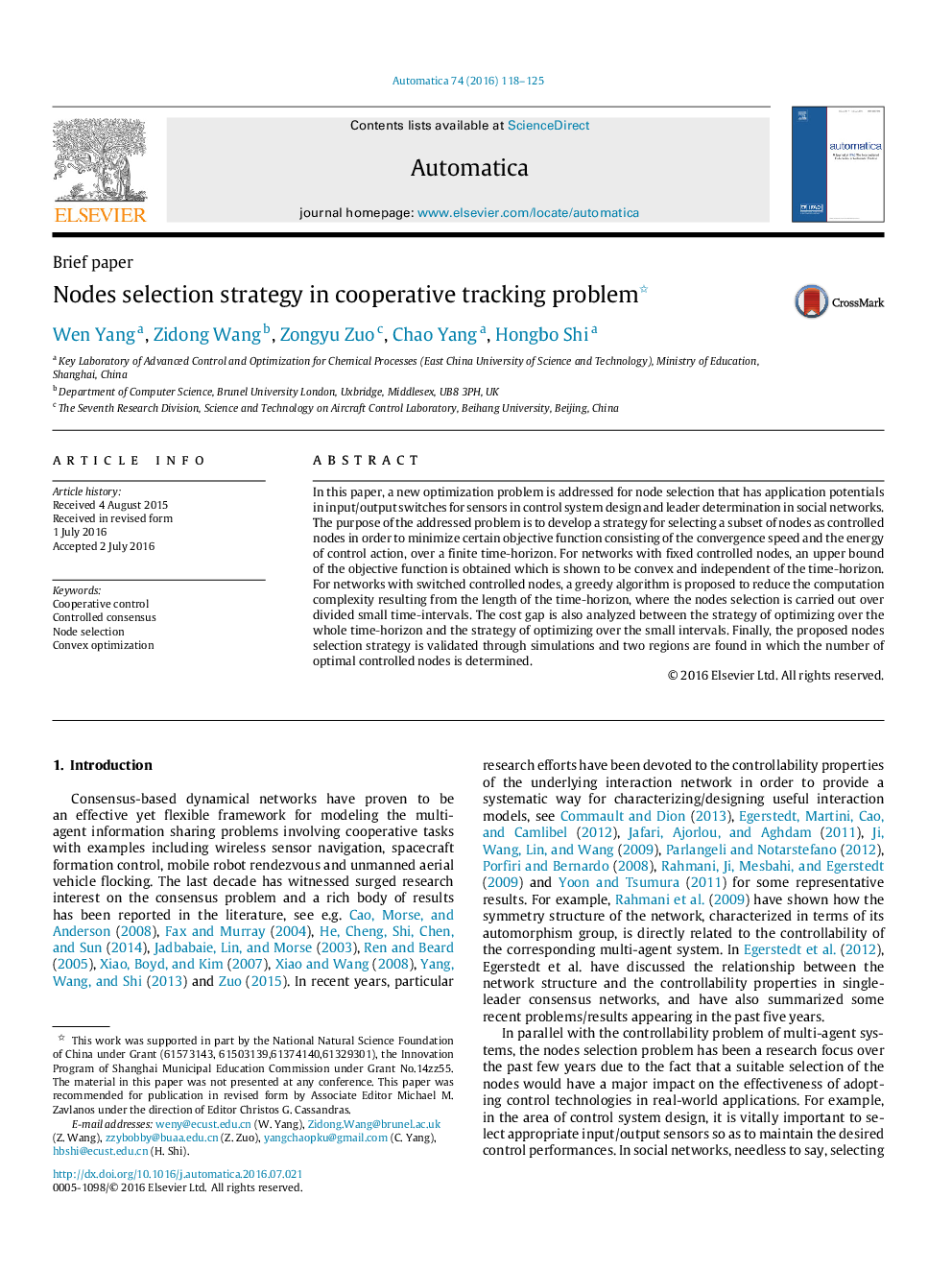| کد مقاله | کد نشریه | سال انتشار | مقاله انگلیسی | نسخه تمام متن |
|---|---|---|---|---|
| 5000172 | 1460641 | 2016 | 8 صفحه PDF | دانلود رایگان |
عنوان انگلیسی مقاله ISI
Nodes selection strategy in cooperative tracking problem
ترجمه فارسی عنوان
استراتژی انتخاب گره ها در مسئله ردیابی تعاونی
دانلود مقاله + سفارش ترجمه
دانلود مقاله ISI انگلیسی
رایگان برای ایرانیان
کلمات کلیدی
کنترل تعاونی، کنترول کنترل شده، انتخاب گره، بهینه سازی محدب،
ترجمه چکیده
در این مقاله، یک مسئله بهینه سازی جدید برای انتخاب گره ای که دارای پتانسیل های کاربردی در سوئیچ های ورودی / خروجی برای سنسورها در طراحی سیستم کنترل و تعیین رهبری در شبکه های اجتماعی است، مورد توجه قرار گرفته است. هدف از این مساله این است که یک استراتژی برای انتخاب یک زیر مجموعه از گره ها به عنوان گره های کنترل شده برای به حداقل رساندن تابع هدف مشخص از سرعت همگرایی و انرژی کنترل عمل در یک افق زمانی محدود ایجاد شود. برای شبکه هایی با گره های کنترل شده ثابت، بدنه بالایی از تابع هدف به دست می آید که نشان داده می شود محدب و مستقل از افق زمان است. برای شبکه های دارای گره های سوئیچ شده، یک الگوریتم حریص برای کاهش پیچیدگی محاسباتی به دست آمده از طول افق زمانی پیشنهاد می شود، در حالی که انتخاب گره ها بر حسب تقسیم زمان های کوتاه تقسیم می شود. شکاف هزینه نیز بین استراتژی بهینه سازی در طول تمام افق زمان و استراتژی بهینه سازی در فواصل کوتاه تجزیه و تحلیل شده است. سرانجام، استراتژی انتخاب گره های پیشنهادی از طریق شبیه سازی معتبر و دو منطقه قابل مشاهده است که در آن تعدادی از گره های کنترل بهینه تعیین می شود.
موضوعات مرتبط
مهندسی و علوم پایه
سایر رشته های مهندسی
کنترل و سیستم های مهندسی
چکیده انگلیسی
In this paper, a new optimization problem is addressed for node selection that has application potentials in input/output switches for sensors in control system design and leader determination in social networks. The purpose of the addressed problem is to develop a strategy for selecting a subset of nodes as controlled nodes in order to minimize certain objective function consisting of the convergence speed and the energy of control action, over a finite time-horizon. For networks with fixed controlled nodes, an upper bound of the objective function is obtained which is shown to be convex and independent of the time-horizon. For networks with switched controlled nodes, a greedy algorithm is proposed to reduce the computation complexity resulting from the length of the time-horizon, where the nodes selection is carried out over divided small time-intervals. The cost gap is also analyzed between the strategy of optimizing over the whole time-horizon and the strategy of optimizing over the small intervals. Finally, the proposed nodes selection strategy is validated through simulations and two regions are found in which the number of optimal controlled nodes is determined.
ناشر
Database: Elsevier - ScienceDirect (ساینس دایرکت)
Journal: Automatica - Volume 74, December 2016, Pages 118-125
Journal: Automatica - Volume 74, December 2016, Pages 118-125
نویسندگان
Wen Yang, Zidong Wang, Zongyu Zuo, Chao Yang, Hongbo Shi,
